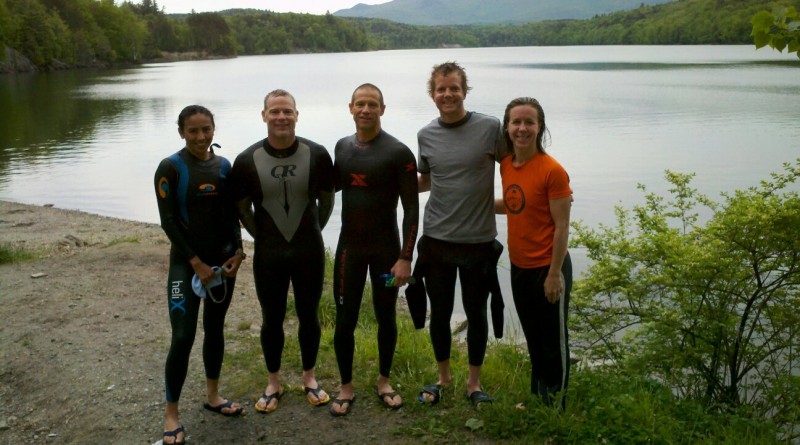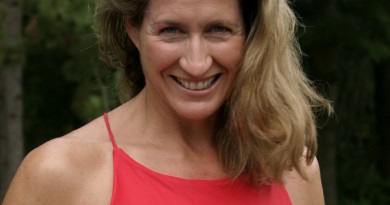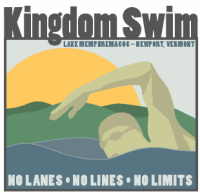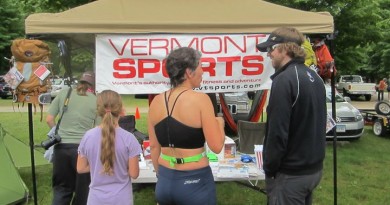Stroke, Technique, Pace | Want to Master Open-Water Swimming? Head to Waterbury
While crowds of people swim and socialize at the popular day-use area off Route 100, a masters swim group meets at a quiet section of the reservoir tucked between the entrance to Little River State Park and the Waterbury Dam. Like the folks at the day-use area, the masters come from near and far to get wet. But unlike casual splashers, these athletes take swimming to another level—practicing pacing, drafting, sighting, and perfecting their strokes. They come together, beginners and veterans alike, to swim and to train.
The Monday night group swim takes place along the shoreline, away from boats and the dam, where the water is shallow enough that swimmers can stand up, if need be.
Chris Kogut, of Charlotte, is a regular at the reservoir swims. She describes them as “relaxed and fun … where people of all abilities come to pace and draft each other, compare stroke techniques, share race experiences and upcoming season goals, and just enjoy being in the outdoors.” Kogut and several other swimmers in regular attendance are coached by John Spinney, an accomplished triathlete who organizes the group. While he may be the organizer, Spinney does not coach the Monday night group. Rather, he is there to swim like everyone else.
In addition to working for the Vermont Agency of Education and training for triathlons, Spinney puts a lot of time and energy into his coaching for QT2 Systems (Quantitative Triathlon Training). He’s a busy guy. Spinney coaches elite athletes as well as beginners. He credits his background in education for helping him differentiate his instruction, something he notices is often lacking from masters swim instruction. Spinney has been coaching open-water masters swimmers since 2005, and in Vermont, that means a lot of pool time.
While Spinney isn’t officially coaching at the Waterbury, he gets asked a lot of questions about form and technique. He explains his coaching approach: “All of the workouts [at the pool] are differentiated so beginner swimmers get what they need and accomplished swimmers get their needs met too,” he says. “The beginner swimmers are doing a lot more drill work and getting more technique feedback, whereas the accomplished swimmers are getting more volume and feedback on what kind of paces they should be able to hit and feedback around how well they paced the set, how was their diet today—yes, it comes up a lot—and subtle technique issues.”
The first focus for open water-swimmers is body position. After that, it’s improving stroke rate. “There is very little distance per stroke when body position is poor,” says Spinney. Characteristics of poor body position are low hips and feet causing the body to sink like an anchor. When needed, Spinney uses an iPhone app called Coach’s Eye that provides swimmers with instant-video feedback.
While a big part of coaching swimmers is physical, there is always the mental component to consider. In open-water swimming, the crowded field can be panic-producing so Spinney teaches athletes how to relax and breathe through anxiety by simulating the crowded scenario of race day.
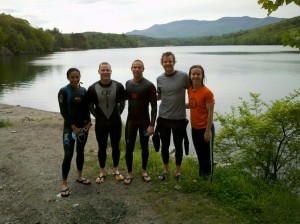
“The nature of open water is that you have currents, chop, swells, and turbulence from other swimmers,” Spinney explains. “It is not the smooth, pristine water you have in a pool. Not to mention the other swimmers. Open-water swims and triathlon swims are typically mass start events, i.e., pack swimming. Open-water racing is a full-contact sport.”
Tucked in a quiet recess of the reservoir, the group swim is low-key, far different than race day, but that doesn’t stop swimmers from pushing each other. “The group swim at the Waterbury Reservoir pushes me beyond my comfort zone in a safe, controlled environment,” shares Tim Cornell, of Middlebury. “There are swimmers and triathletes of all levels, which provides realistic simulation of swimming in a race.”
A skill utilized at races and practiced during the group swims is drafting. Just as cyclists benefit from drafting, so do open-water swimmers, with the potential of saving 18 to 25 percent of one’s energy. At the reservoir, swimmers also work on sighting and swimming in a straight line, skills that are difficult to practice in the lined lanes of a pool.The opportunity to test months of pool practice in the open water is welcomed by the group, and doing so alongside fellow swimmers is a big bonus.
“After a long winter of crowded pool lanes, flip turns, and chlorine, the start of Spinney’s weekly reservoir swims has a big happy face on my calendar,” says Kogut.
Try Testing These Waters
Colchester Pond and Shelburne Beach: Open-Water Swim Clinics
Rayne Herzog, of RaceVermont, will offer a couple of free open-water swim clinics at Colchester Pond and Shelburne Beach when the water warms up. Check the “Latest News” tab on racevermont.com for updates or contact Rayne Herzog at 316-7142 or rayne@racevermont.com.
Northeast Kingdom: Races and Training
The Northeast Kingdom Open-Water Swim Association (NEKOWSA) hosts the well-known races at Lake Memphremagog and Lake Willoughby. New this year: “Swim the Kingdom,” 7 Swims in 9 Days. Race website: kingdomswim.org/NEKOWSA.php. For information on informal training swims on Lake Memphremagog, contact Phil White, swim@orleansrecreation.org.
Waterbury Reservoir: Masters Group Swim
Meets on Monday nights, 5:30 p.m., mid-May to October. Reservoir access is off Route 2 at the Little River State Park entrance. Meet at the parking lot just past the dam. Contact: John Spinney, john@qt2systems.com.

